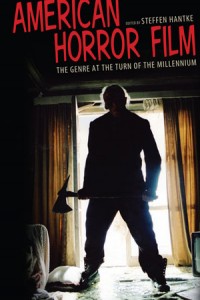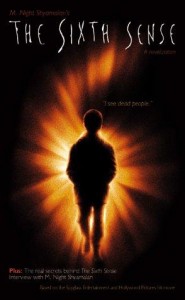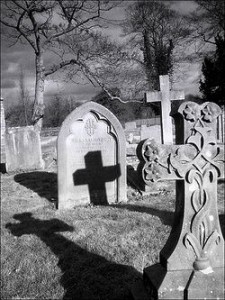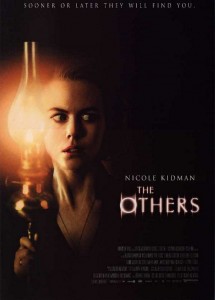 As previously noted here in a discussion based upon an article in The Chronicle of Higher Education, there is a growing body of academic books exploring horror films. One of those books is American Horror Film: The Genre at the Turn of the Millennium, edited by Steffen Hantke (University Press of Mississippi, 2010). While many are critical of the current state of American horror films, the contributors to this book take a different stance:
As previously noted here in a discussion based upon an article in The Chronicle of Higher Education, there is a growing body of academic books exploring horror films. One of those books is American Horror Film: The Genre at the Turn of the Millennium, edited by Steffen Hantke (University Press of Mississippi, 2010). While many are critical of the current state of American horror films, the contributors to this book take a different stance:
Creatively spent and politically irrelevant, the American horror film is a mere ghost of its former self-or so goes the old saw from fans and scholars alike. Taking on this undeserved reputation, the contributors to this collection provide a comprehensive look at a decade of cinematic production, covering a wide variety of material from the last ten years with a clear critical eye.
Individual essays profile the work of up-and-coming director Alexandre Aja and reassess William Malone’s muchmaligned Feardotcom in the light of the torture debate at the end of President George W. Bush’s administration. Other essays look at the economic, social, and formal aspects of the genre; the globalization of the U.S. film industry; the alleged escalation of cinematic violence; and the massive commercial popularity of the remake. Some essays examine specific subgenres-from the teenage horror flick to the serial killer film and the spiritual horror film-as well as the continuing relevance of classic directors such as George A. Romero, David Cronenberg, John Landis, and Stuart Gordon.
Essays deliberate on the marketing of nostalgia and its concomitant aesthetic, and the curiously schizophrenic perspective of fans who happen to be scholars as well. Taken together, the contributors to this collection make a compelling case that American horror cinema is as vital, creative, and thought-provoking as it ever was.
One of the contributors to American Horror is James Kendrick. Kendrick is an assistant professor in the Film and Digital Media Division of the Department of Communication Studies at Baylor University. He is the author of two books, has contributed chapters to others, and has had articles published in peer-reviewed journals. The title of Kendrick’s chapter in American Horror is “A Return to the Graveyard: Notes on the Spiritual Horror Film.”
TheoFantastique: James, I appreciate your willingness to discuss your chapter from American Horror. I appreciated its focus and contribution to the volume. How did you come to have the personal interest to focus on the spiritual in horror films, and how are you defining “spiritual” for the purposes of your discussion?
James Kendrick: I started thinking about this topic a few years ago when all of the talk around the horror genre was focused on so-called “torture porn.” It seemed like that was all anyone wanted to talk about, and there was all of this rumination about whether extreme graphic violence and despondency were going to be the primary characteristics of horror in the future. I recognize why people wanted to talk about this, but I felt like they were leaving out a major part of the story, which is the fact that the late 1990s witnessed a major renaissance of what I term “spiritual” horror films, many of which were extraordinarily popular with mainstream audiences (a rarity for horror), perhaps because almost all of them relied very little, if at all, on any kind of visual gruesomeness. As I describe in the chapter, for my purposes, spiritual horror films are those that focus supernatural issues—those things that are beyond the explanatory scope of rational and scientific understanding, particularly issues of life and death and what follows our existence in the physical world. “Spiritual” differs from “supernatural,” though, in that the latter term usually means anything that is above the natural, whereas the spiritual has a direct connection to the human spirit, that is, the idea that being human transcends mere material existence. There is a sacred element to the spiritual.
 TheoFantastique: You discuss the shift in the constantly evolving horror genre toward the spiritual in the 1990s with several films, most notably The Sixth Sense. What was the general context for horror films then, and how does The Sixth Sense stand out as representing something different?
TheoFantastique: You discuss the shift in the constantly evolving horror genre toward the spiritual in the 1990s with several films, most notably The Sixth Sense. What was the general context for horror films then, and how does The Sixth Sense stand out as representing something different?
James Kendrick: By mid-1990, the general consensus was that the horror genre was all but dead, with a significant drop-off in home video sales and very few successful theatrical releases. There were a few outliers: In the early part of the decade there was a concerted effort by well-regarded filmmakers to reclaim the horror genre with big-budget, star-studded, “intellectual” horror films like Francis Ford Coppola’s version of Bram Stoker’s Dracula (1992), Kenneth Branagh’s take on Mary Shelley’s Frankenstein (1994), and Neil Jordan’s adaptation of Anne Rice’s Interview With the Vampire (1994). Otherwise, there was little on the horror front until Wes Craven’s Scream (1996) kicked off a string of postmodern slasher films that self-consciously played with the basic parameters of the genre by introducing self-aware would-be victims as a reflection of the young, media-savvy, self-aware audience. Scream was a huge success both critically and commercially, so it was followed by two sequels, one in 1997 and one in 2000, and also an avalanche of increasingly silly teen horror movies and sequels like I Know What You Did Last Summer (1997), Disturbing Behavior (1998), The Faculty (1998), Urban Legend (1998), and Final Destination (2000). This also led to the resurrection of several dormant franchises with a new, self-aware spin, including Halloween H20: Twenty Years Later (1998), Jason X (2001), and Bride of Chucky (1998). Ultimately, the majority of these teen-centric films, despite their sometimes clever postmodern trappings, fell victim to the same criticisms that were aimed at slasher films a decade earlier, specifically that they were overly obsessed with creative means of violent death. When The Sixth Sense was released in 1999, it had the feel of something new and different. Quiet, thoughtful, and dramatic, I like to think of it as a horror movie for people who didn’t like horror movies. More importantly, it was a horror movie that asked to be taken seriously in the way it evoked and explored issues of life after death. It had three-dimensional human characters, and it dealt with relationships, both familial and spiritual. For many it was a moving emotional experience, even if they jumped in their seats at times.
 TheoFantastique: In your chapter you discuss the Graveyard School of poets that you see as influential in informing the early roots of horror. Who are these folks, what was their emphasis, and why do we hear more about the Gothic writers than the Graveyard School as significant formative influences on horror?
TheoFantastique: In your chapter you discuss the Graveyard School of poets that you see as influential in informing the early roots of horror. Who are these folks, what was their emphasis, and why do we hear more about the Gothic writers than the Graveyard School as significant formative influences on horror?
James Kendrick: I went round and round with one of the anonymous reviewers about the role the so-called Graveyard School of poets played in both literature and the nascent development of the horror genre. He or she kept insisting that the Gothic writers influenced the Graveyard poets, but all of my research indicated exactly the opposite: Those writers associated with the Graveyard School were writing years, in some cases decades, before the onset of Gothic writing, whose beginning is usually associated with the publication of Horace Walpole’s The Castle of Otranto in 1764. Many of the most famous Graveyard poems were published in the early 1700s. Not many people are familiar with the Graveyard School, and I had never heard of them until I read The Thrill of Fear: 250 Years of Scary Entertainment (1991) by Walter Kendrick (no relation, by the way). They emerged primarily in England in the early 1700s and, although these writers are referred to as a “school,” they were completely unaffiliated; they just happened to focus their poetry on similar themes and images. Some of the most well-known works include Thomas Parnell’s “A Night-Piece on Death” (1722), Edward Young’s nine-volume The Complaint; or Night-Thoughts on Life, Death, and Immortality (1742–1745), Robert Blair’s The Grave (1743), and Thomas Gray’s “Elegy Written in a Country Churchyard” (1751). Walter Kendrick made a strong argument for the importance of the Graveyard poets in establishing many of the visuals associated with the horror genre: black ravens, creepy yew trees, crumbling gravestones, rotted corpses, and the personification of Death as a character. Yet, what struck me about them was the fact that they were using all of the macabre and unsettling imagery not to gross out the audience or scare them for its own sake, but rather to draw attention to the limitations of our earthly, mortal existence and force us to look into the afterlife. The Graveyard poets were among the first to recognize that deep insights into life can only emerge from ruminating on the extreme limit death, an idea that Edmund Burke later explored in Origin of Our Ideas of the Sublime and Beautiful (1757). However, even though the intention of the Graveyard poets was to encourage their readers to consider spiritual issues by bringing them face-to-face with the gory realities of death and decay, they also began the process by which modern horror would eliminate such concerns in favor of gross-out thrills. As Walter Kendrick puts it, “until tombs and skulls lost whatever connection they once had to anybody’s real death and became the icons of a new kind of entertainment.” So, it isn’t hard to see how the Graveyard poets were essential in helping to create the genre we now call “horror.”
TheoFantastique: How does the spiritual emphasis of the Graveyard poets contrast with the general spirituality found in horror of the 1980s?
James Kendrick: Well, the Graveyard poets were avowedly Christian. Most of them were actually monks and priests who lived in the church and drew some of their inspiration from looking at the church graveyards every day. Mainstream movies, horror and otherwise, are rarely specifically tied to a particular religion, if only because they runs the risk of alienating part of the potential audience. Thus, most horror movies that deal with spiritual issues do not adhere to any particular spiritual tenets or religious beliefs, with the exception of Catholicism, which is also evoked whenever you have a movie about anything demonic. Rather, the spiritual nature of most horror films is kept deliberately vague. In the chapter I describe it as a sort of “grab bag” approach that borrows liberally from Christianity, Judaism, Buddhism, and various New Age belief systems without specifically citing any well-known figures, texts, or creeds. So, unlike the Graveyard poets, whose works were specifically Christian in theology and intent, Hollywood films in the late 1990s, and many horror films in particular, took a generally open, abstract approach to issues of spirituality, borrowing liberally from many theologies without adhering to any one of them.
TheoFantastique: At one point in your chapter you mention the Freudian concept of “the return of the repressed” that is often found in horror analysis, particularly in the writing of Robin Wood. But while she applies this to, as you say, “cultural issues such as race, gender, and sexuality,” you apply it to spirituality. I hadn’t thought of this interesting application before. How do you make this connection?
James Kendrick: In general, the use of the Freudian “return of the repressed” in film studies has been tied to a specific ideological/cultural agenda, which is to discuss the social-conservative repression of mostly sexual issues, which, as Freud noted, can only be repressed so long before they eventually rupture the surface. It seemed to me that, ironically enough, issues of spirituality and religion are often repressed in mainstream cinema, and this cycle of spiritual horror films in the late 1990s and early 2000s represented a sort of “return of the repressed.” You also find this within the narratives of the film themselves, which frequently include characters who deny the existence of anything spiritual but are eventually forced to confront that which they cannot explain scientifically or rationally. Thus, many of these films feature “conversion” narratives, in which characters (many of whom are avowed atheists) ultimately come to accept the existence of the supernatural and the spiritual after meeting it face to face.
TheoFantastique: With horror trending toward violence and mayhem do you see a possible shift in the future toward supernatural horror and the continued influence of the Graveyard poets?
James Kendrick: Like all genres, the horror film is constantly cycling and fluctuating and changing. In fact, the history of the horror film in many ways can be traced along a path of oscillation between a focus on the spiritual and a focus on the material. The horror genre’s embrace of the spiritual at the end of the 1990s did not replace more physical, violent horror, and neither did the explosion of “torture porn” and other forms of extreme horror in the early 2000s replace the spiritual horror film. Rather, as I note in the chapter, each movement is just another arc in the constant evolution of the genre, which over the decades has swung back and forth with varying degrees of force between the visceral and the suggestive, the graphic and the contemplative, the material and the spiritual. That, in my mind, is precisely what keeps the genre interesting. It always has something to say.
TheoFantastique: James, thank you again for your time and thoughts on this topic.






One Response to “American Horror Film: James Kendrick and Spiritual Horror Films”